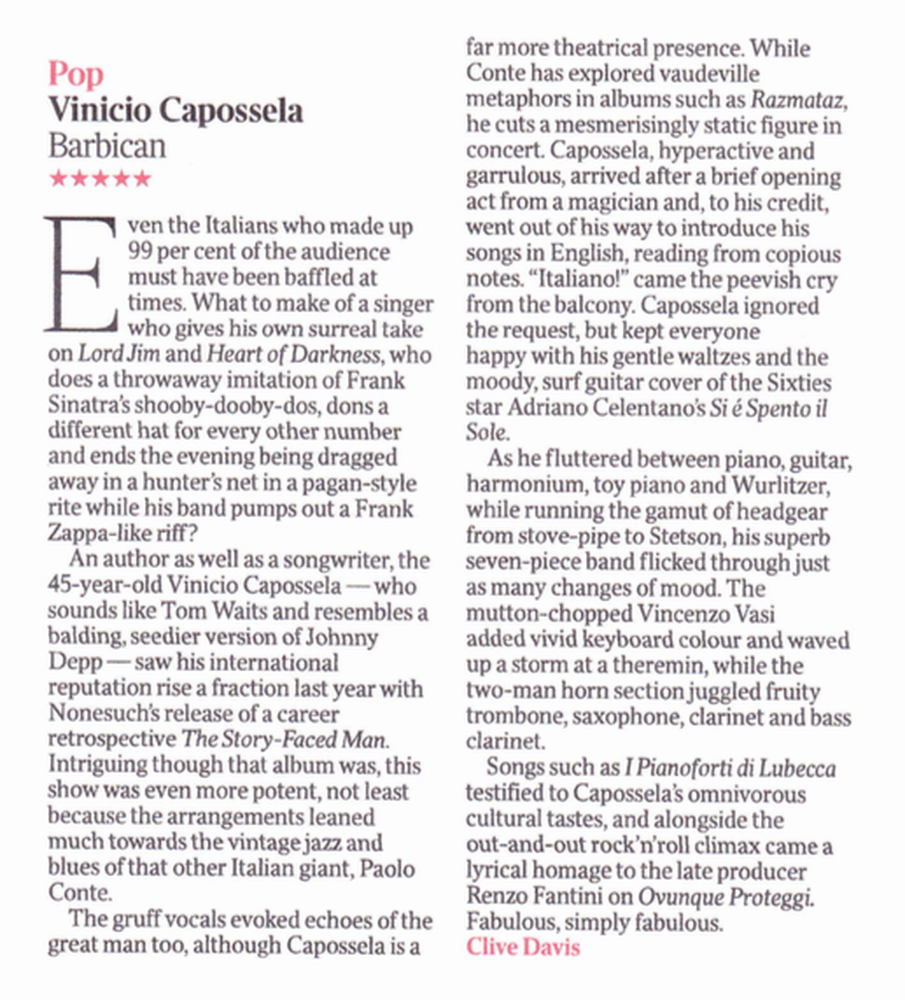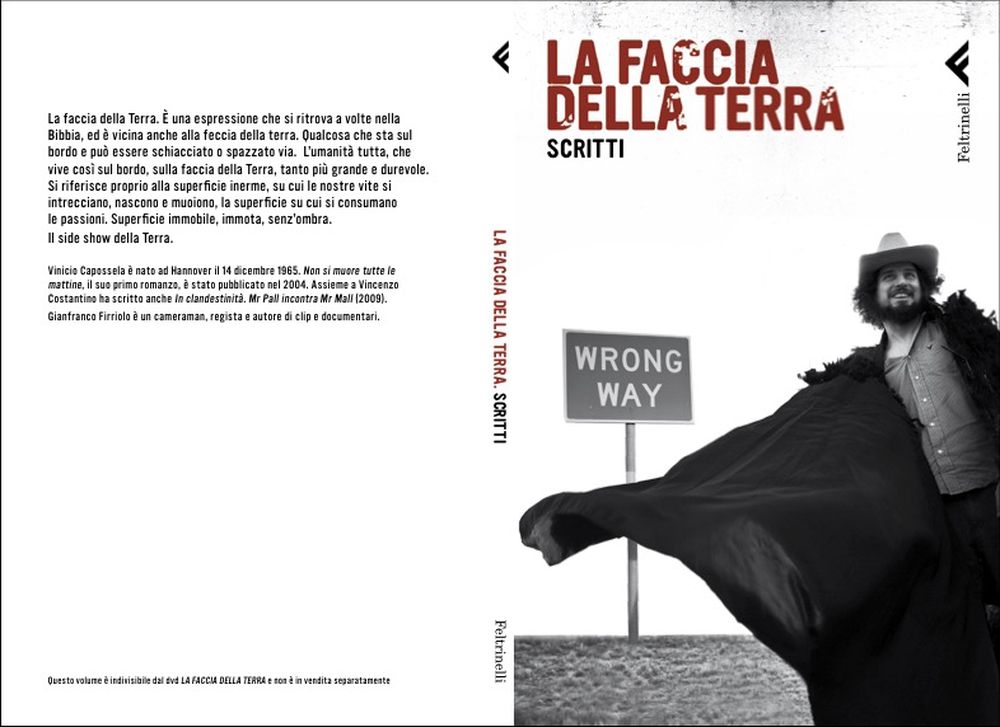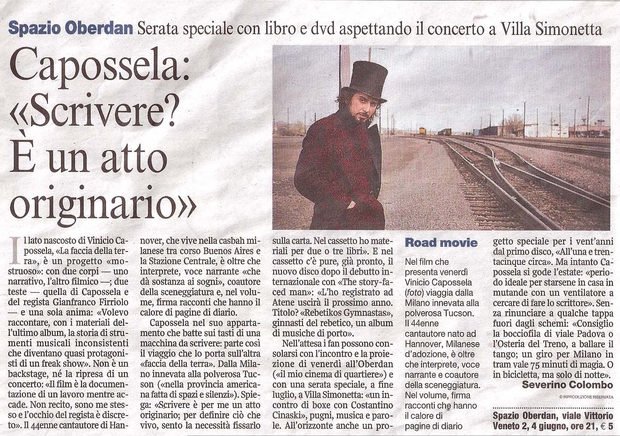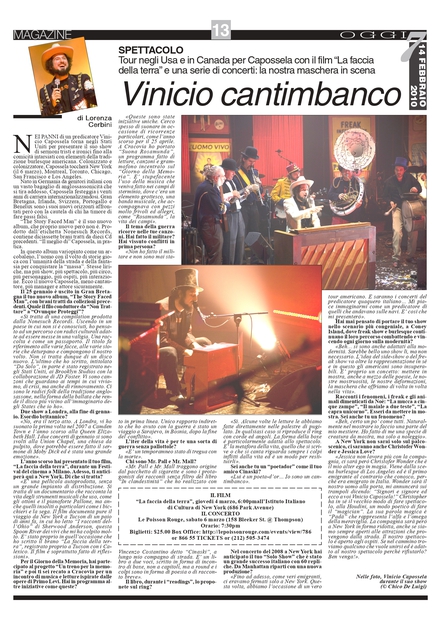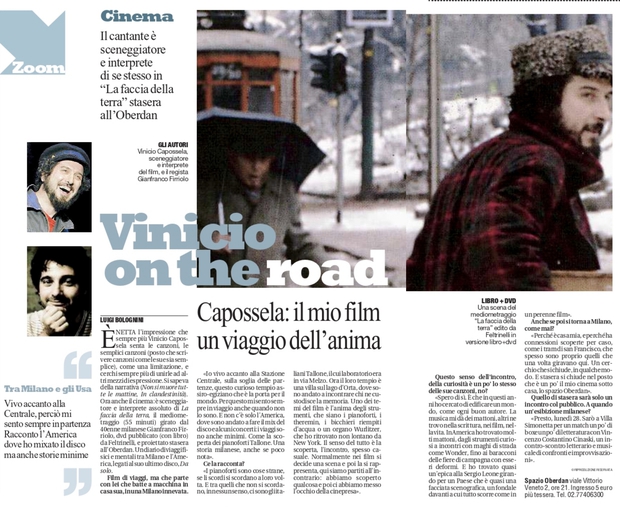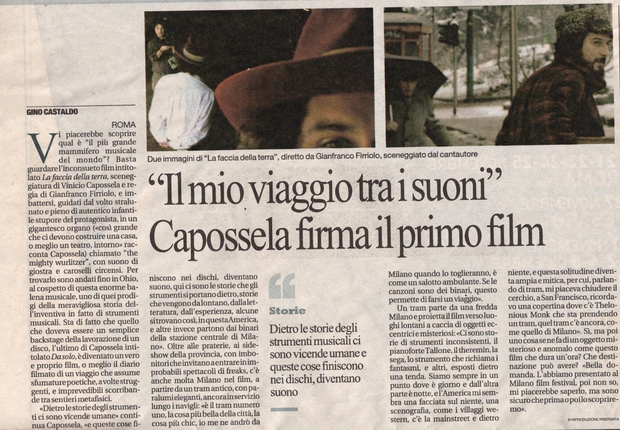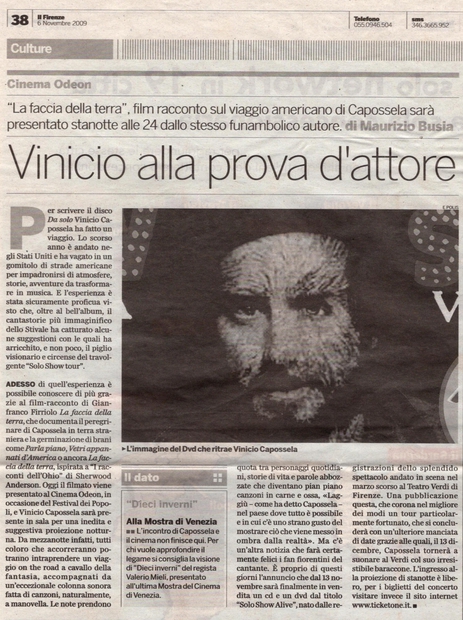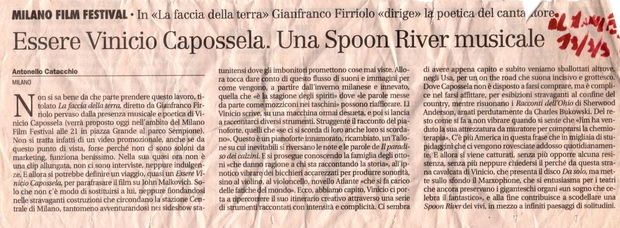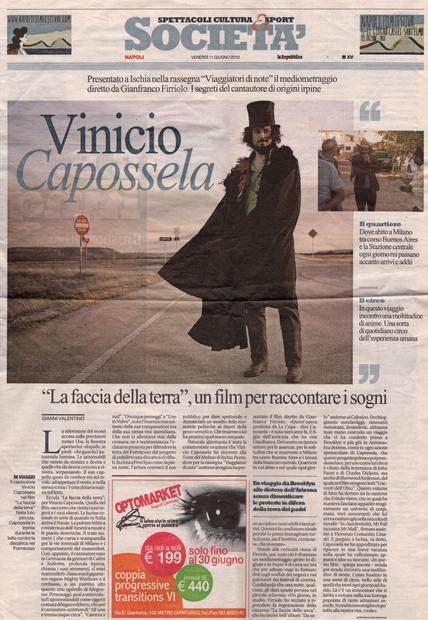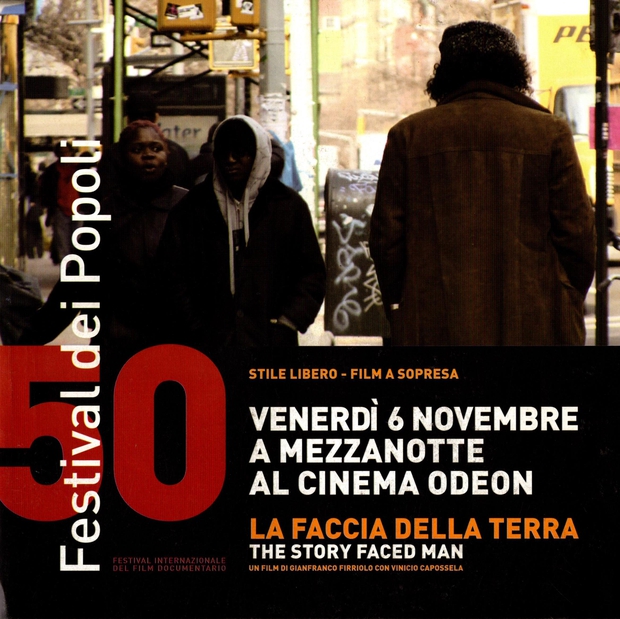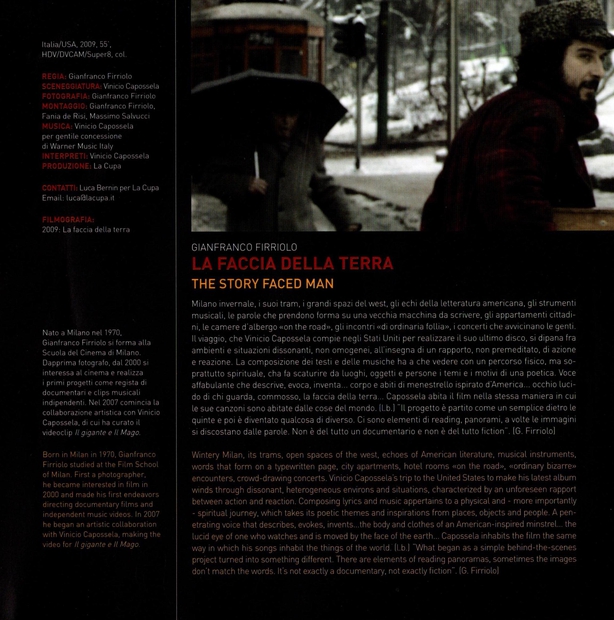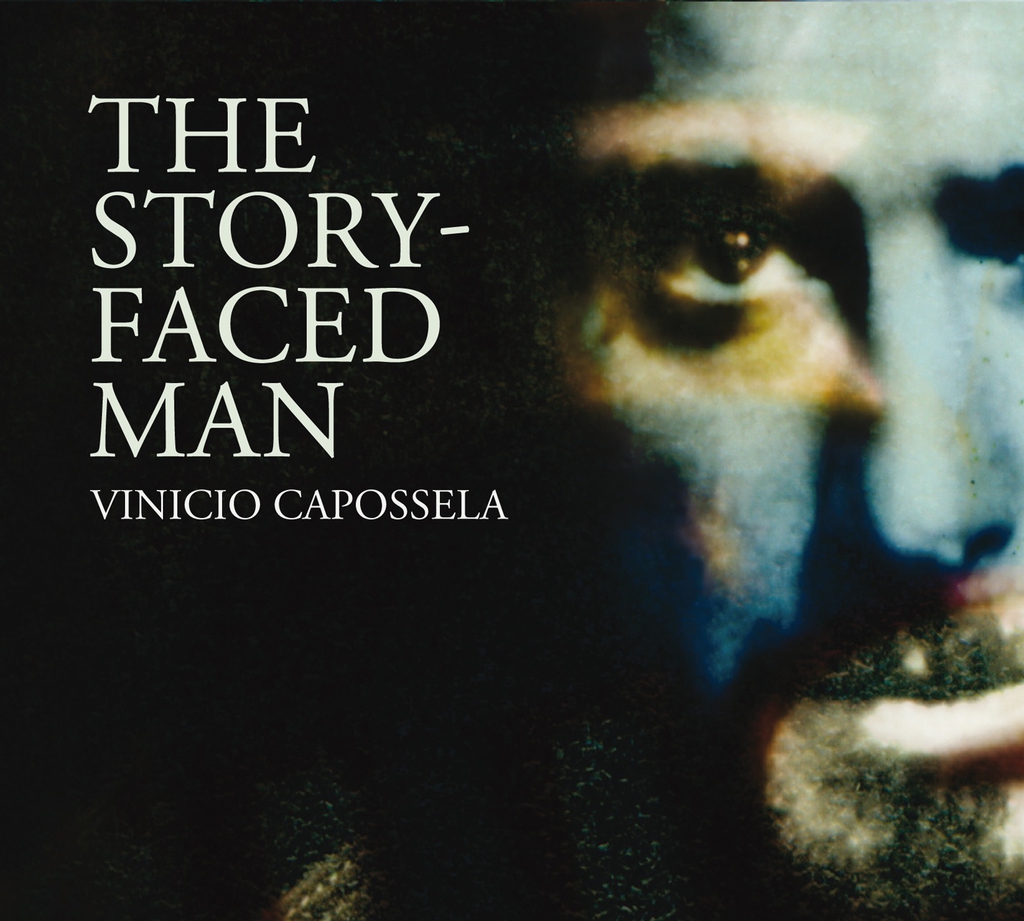
The Story|Faced Man e La faccia della Terra
The Story faced man, an introduction to Vinicio Capossela
There might be eight million stories, but there is only one Vinicio Capossela, an artist inspired by love, history and a curiosity about the relationship between his native Italy and the rest of the world. His is the demimonde of the sideshows rather than the circus, a more intimate place, where surprising things happen, where minotaurs, cowboys and Medusa vie for attention, and where giants, maharajahs and magicians have their hearts broken.
His story began in 1990, with All’una e trentacinque circa. “You know Round midnight?” he says. “This is Around 1.35am. I wanted a time when nothing important happens.” When critics anointed him “the Italian Tom Waits”, he replied with the album Modì, its title both tribute to his hero, Modigliani, and a play on the French word maudit(cursed). On his third album, Camera a sud, he explored the relationship between America and Italy. The bigger country built itself using the people and talent of the Old World, but sent back music it called “latin” and “jazz”.
America continues to intrigue - witness La faccia della terra, from 2008’s Da solo, recorded in Arizona with Calexico – but Capossela’s story took a unique turn with Il ballo di San Vito in 1996, an album about the life he knew best. Rather than imitate the latest American or British thing, he decided to play for the people in front of him, to create a modern Italian musical lexicon. “I used to go to weddings in the south, where my parents come from,” he explains. “I loved the small bands that played there and the strange instruments they used. So I wrote an entirely Italian album, a picture of the whole country from road level.” In a country isolated by language from the world’s pop music markets, it was an audacious move, but this was the beginning of his backwards journey into history.
Waltzes, polkas and even rebetiko - the dances of the Old World – became second nature on Canzoni a manovella, the Italian album of the year in 2000. Here Capossela travelled the world in unconventional style, from central and eastern Europe to the Mexican border, never afraid to visit frontiers, blend cultures or ignore the signs that say “Do not cross”. Six years passed before the next album, Ovunque proteggi, took this a step further, immersing the writer in the myths and legends of the ancient world, refusing to compromise, throwing his audience to the lions of the Colosseum and celebrating the independent spirits whose rites ignore conformity and the corporate world. “Italy is a small country,” Capossela says, “but it has deep roots.”
Dig down and there is much more to uncover about Vinicio Capossela – the short stories and poetry, the wrestling and Michelangelo … This, then, is only Chapter 1, the rest is written on his face.
David Hutcheon
La faccia della terra
In 2010, Vinicio Capossela and Feltrinelli released a film, made up of a dvd and a book, named «La faccia della terra». This film must be considered as a physical and interior journey between the stories behind the recordings of Capossela's album, «Da solo»; in fact, the film's name echoes one of the songs featured in the album.
It is an on the road film-story, discovering disappeared seasons, inconsistent instruments, fantasy or everyday characters, pages of life becoming songs, accidental and fatal meetings, mirroring solitudes, American side shows.
Directed with mixed techniques by Gianfranco Firriolo, «La faccia della terra» offers a new view on Vinicio Capossela's artistic universe: in this way, the film becomes a first-person narration of the creative process that lies behind every story and every songs. Transforming what formerly had to be just the recording of the backstage, Firriolo blended many techniques like readings, video poetry and music video.
Reality, fiction and surreal alternate in this unique film, which shows much more that just what is "behind the scenes".
«La faccia della terra»'s trailer
Directed by Gianfranco Firriolo.
Director's notes
In «La faccia della terra», Vinicio Capossela is shown without filters, without masks: it is just the artist and his inspirations.
He confessed me that he almost forgot that I was near him making this film, thanks to technology: digital engines make everything much easier and they allow to be always ready to capture the right moment when something is happening. In my opinion, this gives much more value to the film.
Around and with Vinicio there were other actors, places, landscapes, cities, streets, stations, platforms, motels, their absurd tapestry and tv, rooms, amusement parks and all the places that, as Wenders says, «must be respected; they ask for much respect as we give to actors».
I think that all the «behind the scenes» films look the same: movement shootings, long interviews whose answers, most of the times, already are on the internet... I needed something different, that is why I decided to make narrow and detailed shootings, trying to express the essence of things, especially of instruments. I wanted also to exaggerate Vinicio's facial expressions, making them "talk", and focusing on his hands moving on the keys of the piano like in a dance.
Once back from the journey in the US, the record was ready, so I wondered about what to do with the twentyfive hours recordings I had. Can a "behind the scenes" film turn into something more poetic? Perhaps. I had this will to let people know Vinicio out of YouTube, out of the interviews and mobile phones. This was the question: what lies behind every song? What is his bond with writing? Which stories are behind his stories? I did not want to include the interviews that I recorded during the journey, so I decided to join images and Vinicio's own thoughts and tales together.
The film is made of two parts: the first one is about the stories of those weird instruments that have been used during the album's recording.
The context is still surreal: when we see Vinicio walking in the tunnel of a metaphorical side show, it is actually the imaginific creation that he made of himself when he's been struck at Austin's side show.
In the second part, the lines swap: the texts come from the pages of his old American diaries and from two extracts from «Winesburg, Ohio». Here, the choice of images has been a little harder to make.
The language of video poetry prevails, especially during the first extract from the book, «Solitudes», about the character named Enoch. Which is Vinicio's point of view and which is Enoch's? Where is the edge between them?
...In the mean time we hear some drums, the narration becomes even more dramatic...
A pair of scenes, however, bring us back to reality: the Brooklyn recording studio and a drummer reminds us that, well, Vinicio is there to work on his album.
Anyway, Vinicio is "a looking man", he observes the world and the face of the earth through the windows of his house in Milan, from motels and their tvs, from the tunnel of the side show, from his imagination. These are different worlds put together like in a visual matrioska. Vinicio fully dives in what strikes him and the passion coming from it makes him unique. That is his attitude: he sees things as they really are, without any filter, with the eyes of a baby. He watches things, he does not only see them. He doesn't just feel emotions, he does not ask himself why he is feeling them, he lives them.
Living this way, a tramway in Milan is not just a tramway, it is a metaphor of time; a barker, that everybody would define trash or kitsch awakens in Vinicio that reaction, that face - the storyfacedman - and becomes the inspiration for a fascinating and magic show like the «Solo Show».
That is how the boundless places and silences of America, even if you have seen them many times, become new and ancient at the same time.
Normal life, meanwhile, goes on. The wolf-man emprisoned in glue and paper watches us.
Enjoy.
Gianfranco Firriolo
